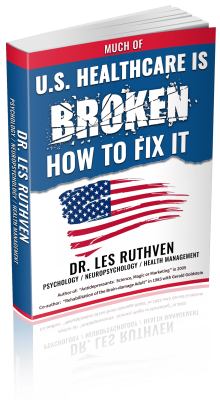Last updated on September 26th, 2024 at 11:11 am
Les Ruthven, Ph.D. clinical psychology
Health blog: www.ruthvenassessments.com
Email: dr.les.ruthven@gmail.com
From Dr. Ruthven’s 20 years of specializing in clinical neuropsychology, combined with his 20 years of experience managing behavioral healthcare for large employers, he knew that there existed major quality and high cost problems in the early identification of cognitive impairment (Ci) in healthcare plans, which results in an inefficient and expensive path to the final diagnosis. Even now general physicians, with little training or expertise with regard to brain-behavior relationships, have almost sole responsibility to identify Ci in their patients and for directing the referral path of these patients to a health professional, mainly a neurologist, to make the correct diagnosis. Neurologists have a major role in the diagnosis of structural brain pathology but if neurology continues to be the first step in the Ci diagnostic process, as neurologists are now, this process will continue to be inefficient time wise and horrendously costly. For example Ci arises from dozens of sources, many of which at least in the early stages do not cause structural brain damage. When the neurologist finds no evidence of brain damage after a 6 to 8 thousand dollar work-up, from Dr. Ruthven’s experience the patient
is often told there is no evidence of brain damage and his/her mental impairments must be in the realm of psychiatry. This back door diagnosis (based on negative neurological findings) must stop if we are ever to have a more cost efficient diagnosis of the source or sources of the Ci.
Dr. Ruthven saw the need for a systematic approach for (1) a cost efficient and early identification of Ci in patients in a health plan and (2) once identified a clinical psychologist or neuropsychologist with the assistance of other neuroscience professionals would refer to appropriate health professionals to obtain the final and correct impairing diagnosis prior to treatment/rehabilitation.
There are in use a dozen or more cognitive screening tests to begin the assessment process but Dr. Ruthven believes these tests, as a group, are insufficient for the task needed (e.g., too many false positive and false negative findings). Many forms of brain impairment are reversible (many prescription medications, mental health problems) and many others are irreversible (e.g., structural damage to the brain). A screening test that could make this differentiation reliably and validly should shorten the time and cost to obtain the final diagnosis. In retrospect it can take 10 years or more before some AZ patient’s progressive dementia is finally diagnosed.
Such a powerful screening test would be performed on a desktop computer, would need to be self-administered for most persons (a monitor would be required for more impaired persons), the tasks would be performed in 15 minutes or less, performances over time would be stored in a database. In addition to the test itself, the person on the computer would respond to questions involving their medical and prescription drug history and there would be a brief 10 item behavior and symptom survey. The cost would have to be $25.00 or less per testing. A clinician, such as a clinical psychologist or
neuropsychologist, would have access to and analyze subject’s test performances over time, medical and drug history and behavior/symptom survey, consider the diagnostic possibilities and arrange further diagnostic procedures when needed.
In a health plan covered lives (ages 12 and older with average computer skills) would take the RIA to establish a cognitive baseline and take the RIA perhaps twice a year or when the person or other healthcare professionals suspect possible Ci in the patient. This test performance would initiate the diagnostic process and hopefully differentiate reversible Ci or irreversible structural damage to the brain.
The RIA test pattern differentiation between reversible and irreversible (i.e. structural) brain damage
The first three RIA subtests, performed on a standard clock face by bar pressing to instructions, are simple, complex and conditional RT. According to RIA norms, In non-impaired Ss complex and conditional RT are both 50% slower than simple RT. The greater the decrement in RT across the 3 RT measures the greater the S’s Ci. Subtest 4, a measure of attention/memory involving number sequences (2 sets of 3 numbers, then 4 numbers, 5 numbers, and 6 numbers), is mastered quite well by Ci normal Ss. Subtest 5, the one of the 9 measures that is highly correlated with IQ, is a measure of anticipatory thinking or complex problem solving; here the S is presented with 13 sets of 5 lighted number series, is instructed to determine a theme or pattern in each sequence and to left click with the mouse on two clock numbers that continue or complete the theme or pattern. On the first 3
explanatory items, one series is clock numbers 1, 2 , 3, 4 , 5 and the correct response is obviously to click on the numbers 6 and 7 to continue the pattern.
At this stage of RIA development if there are indications of Ci on the first 4 subtests reversible brain impairment is considered but structural brain damage (either static or progressive) requires significant impairment of the complex problem solving difficulties on subtest 5. For example, PTSD would be a case of reversible Ci reflecting the effects of severe anxiety and performance on subtest 5 would likely to be normal or near normal. A patient with a TBI, however, would be expected to be most impaired on subtest 5 and show lesser impairment on the first 4 subtests of the RIA. AZ patients would show the greatest impairment on memory and lesser impairment on anticipatory thinking in the earlier stages of the disease.
Clinical psychologists and neuropsychologists who are interested in accessing 25 free RIA testings to evaluate the procedure should contact Dr. Ruthven at dr.les.ruthven@gmail.com
The pervasiveness, complexity, extent in the population, range of impairment and horrendous cost of the Ci problem in US healthcare requires a systematic solution by experts in the cognitive sciences The solution requires a carve out from the rest of the health plan and not primary care physicians who provide and arrange these diagnostic services presently.



